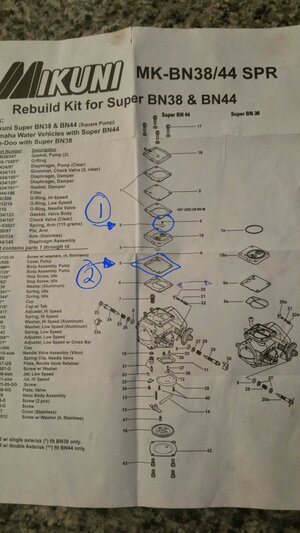- Location
- Houston Texas
I need some help, Im not so sure i can trust what my mechanic said?
I have a stock 1991 SJ650 that has just had a new set of reeds installed after one broke and went through the motor (I did all the work myself replacing the entire set of reeds/inspecting the motor and not the shop). Everything is still in excellent shape as we opened the crank case and saw no damage, and both cylinders tested with 155psi of compression, and saw no scratches when we borescoped the motor. Sadly we tore into the carburetor (which was our first guess to do as we couldn't get the ski to run or suck fuel through the lines) before we found it was a broken reed on the front cylinder, we had rebuilt the carburetor exactly as the manual shows, but we still had a enormous amount of trouble getting it to run right (particularly the pop off pressure). I then decided to take the carburetor to my mechanic as I have spent half my summer on this silly carburetor. He was telling me that the pop off pressure should be 55 psi stock, as and that I have the wrong carburetor for my year model. He said that the aluminium block that holds the clear plastic circles that act as check valves on the pump side was for another year of carburetor (a 1995) and I need one for a 1991. I'm pretty good with engines and when I Put the carb kit in myself everything (all the gaskets and diaphragms and pump parts in the new kit) fit and looked right so??? Plus The ski ran awesome before we jacked with the carburetor. It has a 120 for the pilot jet and a 115 for the high speed jet.
Are these the stock jets and pop off pressure for a 1991 superjet 650 and is there any difference besides the jets and dual carbs between different years of superjets?????
Thank you in advance to any one who can help me make sure I'm not getting told the wrong thing by a shop. ; )
I have a stock 1991 SJ650 that has just had a new set of reeds installed after one broke and went through the motor (I did all the work myself replacing the entire set of reeds/inspecting the motor and not the shop). Everything is still in excellent shape as we opened the crank case and saw no damage, and both cylinders tested with 155psi of compression, and saw no scratches when we borescoped the motor. Sadly we tore into the carburetor (which was our first guess to do as we couldn't get the ski to run or suck fuel through the lines) before we found it was a broken reed on the front cylinder, we had rebuilt the carburetor exactly as the manual shows, but we still had a enormous amount of trouble getting it to run right (particularly the pop off pressure). I then decided to take the carburetor to my mechanic as I have spent half my summer on this silly carburetor. He was telling me that the pop off pressure should be 55 psi stock, as and that I have the wrong carburetor for my year model. He said that the aluminium block that holds the clear plastic circles that act as check valves on the pump side was for another year of carburetor (a 1995) and I need one for a 1991. I'm pretty good with engines and when I Put the carb kit in myself everything (all the gaskets and diaphragms and pump parts in the new kit) fit and looked right so??? Plus The ski ran awesome before we jacked with the carburetor. It has a 120 for the pilot jet and a 115 for the high speed jet.
Are these the stock jets and pop off pressure for a 1991 superjet 650 and is there any difference besides the jets and dual carbs between different years of superjets?????
Thank you in advance to any one who can help me make sure I'm not getting told the wrong thing by a shop. ; )

